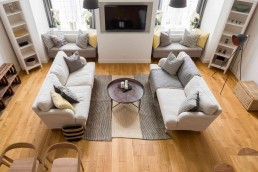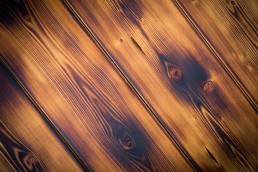The Environmental Benefits of Hardwood Flooring
With Earth Day just passing, now more than ever it is super important to look at your environmental footprint and ensure you are not creating waste. If you are looking for a sustainable flooring option, Hardwood Flooring may be the proper option for you!
- Renewable Resource: Hardwood comes from trees, which is a renewable and biodegradable resources. Unlike non-renewable flooring materials such as carpet or vinyl, which rely on fossil fuels and synthetic compounds. Because of this, Hardwood can be recycled and reused in many different ways.
- Energy Efficiency: Hardwood flooring offers energy efficiency benefits, particularly in homes with radiant heating systems. Wood has natural insulating properties that help retain heat, reducing the energy required for heating and cooling.
- Biodegradability: When you are done with your hardwood flooring, it is biodegradable and can be recycled or composted, minimizing its environmental impact compared to non-biodegradable materials. Hardwood flooring also has the ability to be repurposed or reused in many different ways.
Want to learn more about the benefits of Hardwood Flooring? Connect with one of our team members today, and we can walk you through the benefits of hardwood flooring.
When and How to Refinish Your Hardwood Floors
Hardwood flooring adds timeless beauty and elegance to any home, but over time, wear and tear can take a toll on its appearance. Thankfully, hardwood floor refinishing offers a cost-effective solution to restore your floors to their former glory. In this guide, we'll delve into the ins and outs of hardwood floor refinishing, including when it's necessary and how to go about the refinishing process.
When to Refinish Your Hardwood Floors:
- Visible Signs of Wear and Damage: Scratches, dents, and stains are common signs that your hardwood floors are due for refinishing. If the damage is superficial and hasn't penetrated the wood, a simple refinishing job can renew their appearance.
- Fading or Discoloration: Sun exposure and foot traffic can cause hardwood floors to lose their luster and fade over time. Refinishing can revive the color and restore the natural beauty of your floors.
- Widespread Surface Imperfections: If your floors have numerous deep scratches, gouges, or water damage, refinishing may be necessary to repair the surface and prevent further deterioration.
- Dulling of Finish: High-traffic areas may show signs of wear where the finish has worn away, leaving the wood vulnerable to damage. Refinishing restores the protective layer and enhances the durability of your floors.
How to Refinish Your Hardwood Floors:
- Preparation: Begin by clearing the room of furniture and rugs. Thoroughly clean the floors to remove dirt, dust, and debris. If necessary, use a wood cleaner to remove stubborn stains.
- Sanding: Sanding is a crucial step in the refinishing process, as it removes the existing finish and smooths out imperfections in the wood. Start with a coarse-grit sandpaper to strip away the old finish, then gradually switch to finer grits for a smooth, even surface.
- Staining (Optional): If you desire a change in color or want to refresh the existing stain, apply a wood stain evenly to the sanded surface. Allow the stain to dry completely before proceeding to the next step.
- Applying Finish: Once the stain has dried, it's time to apply the finish. Choose a polyurethane finish for maximum durability and protection against wear and tear. Use a brush or applicator pad to apply the finish in long, even strokes, working with the grain of the wood. Allow the first coat to dry thoroughly before applying additional coats as needed.
- Curing: After applying the final coat of finish, allow the floors to cure for the recommended time before walking on them or replacing furniture.
Conclusion: Hardwood floor refinishing is a cost-effective way to breathe new life into your floors and enhance the beauty of your home. By knowing when to refinish your floors and following the proper steps, you can enjoy the timeless elegance of hardwood flooring for years to come. If you're unsure about tackling the refinishing process yourself, consider hiring a professional to ensure the best results.
Timeless Elegance: Why Hardwood Flooring Is the Ideal Choice for Your Projects in 2024
As we step into 2024, the world of interior design and home improvement is witnessing a resurgence of classic choices. One timeless option that continues to dominate the scene is hardwood flooring. In this blog, we'll delve into the enduring appeal of hardwood floors and why it remains an excellent choice for your projects this year.
**The Timeless Allure of Hardwood Flooring:**
Hardwood flooring has stood the test of time, captivating homeowners and designers alike with its timeless elegance. Its warm, natural tones and rich textures create an inviting ambiance in any space, making it a perennial favorite for those seeking a blend of sophistication and comfort.
**Durability and Longevity:**
One of the standout features of hardwood flooring is its durability. In 2024, with an increasing emphasis on sustainable and long-lasting materials, hardwood flooring emerges as a frontrunner. High-quality hardwood can withstand heavy foot traffic, making it an ideal choice for both residential and commercial spaces. Additionally, with proper care and maintenance, hardwood floors can last for generations, proving to be a wise investment for any project.
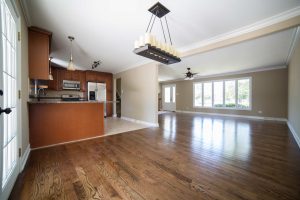
**Aesthetic Versatility:**
Hardwood flooring is a chameleon in the design world, seamlessly adapting to a variety of interior styles. From classic to contemporary, hardwood's versatility is unmatched. Whether you prefer the warm hues of oak, the deep richness of mahogany, or the modern appeal of lighter tones like maple, hardwood offers an extensive range of options to suit your aesthetic preferences.
**Natural Beauty and Authenticity:**
In an era where authenticity is cherished, hardwood flooring stands out for its genuine and natural appeal. Each plank tells a unique story, showcasing the knots, grains, and imperfections that add character and authenticity to the space. In 2024, as the demand for organic and authentic materials rises, hardwood flooring aligns perfectly with the ethos of embracing nature in design.
**Health and Environmental Benefits:**
Hardwood flooring contributes not only to the visual appeal of a space but also to its overall health. Unlike carpets that may trap allergens, hardwood floors are hypoallergenic and easy to clean. In an age where health-conscious choices are gaining prominence, hardwood flooring provides an environment-friendly solution.
From an environmental standpoint, responsibly sourced hardwood, certified by organizations like the Forest Stewardship Council (FSC), ensures that the material comes from sustainably managed forests. This commitment to eco-friendliness aligns with the growing trend of incorporating sustainable practices in interior design.
**Ease of Maintenance:**
Busy lifestyles demand low-maintenance solutions, and hardwood flooring fits the bill perfectly. Regular sweeping and occasional polishing are usually all it takes to keep hardwood floors looking pristine. In an era where time is a precious commodity, the ease of maintenance associated with hardwood flooring is a significant advantage.
**Incorporating Modern Technology:**
While hardwood flooring embraces tradition, it also adapts to modern technological advancements. In 2024, innovations in hardwood flooring include finishes that enhance durability and resistance to wear and tear. Additionally, precision milling and installation techniques ensure a seamless, modern look while preserving the classic charm of hardwood.
**Increased Property Value:**
Investing in hardwood flooring is not just an aesthetic choice but a smart financial decision. Homes and spaces adorned with hardwood floors tend to have higher resale values. Potential buyers often view hardwood flooring as a premium feature, adding to the property's overall appeal. In the competitive real estate market of 2024, hardwood flooring can give your project a distinct edge.
**Conclusion:**
As we navigate the design landscape of 2024, one thing remains clear: hardwood flooring is not merely a trend; it's a timeless classic that continues to reign supreme. With its durability, aesthetic versatility, natural beauty, and environmental benefits, hardwood flooring stands as an ideal choice for your projects this year. Whether you're renovating a home, designing a commercial space, or embarking on a new construction project, hardwood flooring promises to elevate the ambiance, creating a lasting impression that transcends fleeting design fads. Embrace the enduring allure of hardwood flooring – where tradition meets modernity in perfect harmony.
Unveiling the Charms of Hardwood Flooring: A Basement Marvel

**1. Durability Beyond Compare:**
Basements often face challenges like moisture and temperature fluctuations. Hardwood flooring, when properly installed and finished, proves to be resilient against these conditions. Unlike some flooring materials that may warp or degrade in damp environments, hardwood maintains its structural integrity, ensuring a long-lasting investment that stands the test of time.
**2. Elegance Meets Versatility:**
Hardwood flooring is synonymous with sophistication. Its natural beauty adds a touch of elegance to any space, transforming your basement into a welcoming and stylish area. Additionally, the versatility of hardwood allows it to complement various design styles, from classic to contemporary, making it an ideal choice for homeowners with diverse aesthetic preferences.
**3. Warmth Underfoot:**
One of the distinctive qualities of hardwood is its ability to create a warm and inviting atmosphere. Unlike cold and unyielding surfaces like concrete, hardwood provides a comfortable and cozy feel underfoot. This feature is particularly valuable in basements, where the right flooring can turn an otherwise underutilized space into a cozy retreat for family and friends.
**4. Easy Maintenance:**
Hardwood flooring is renowned for its ease of maintenance. Regular sweeping and occasional mopping are usually sufficient to keep it clean and looking its best. This low-maintenance aspect is especially appealing in basements, where practicality is paramount. Unlike some flooring materials that require special care, hardwood simplifies the upkeep of your basement space.
**5. Timeless Appeal:**
Investing in hardwood floor is an investment in timelessness. While trends may come and go, the classic beauty of hardwood endures. Choosing hardwood for your basement project means creating a space that remains relevant and appealing for years to come. It's a choice that transcends fleeting fashions, ensuring that your basement stands out with enduring charm.
**6. Increased Property Value:**
Hardwood flooring has the power to enhance the overall value of your property. Potential homebuyers are often drawn to the timeless elegance and durability associated with hardwood. By opting for hardwood in your basement project, you not only elevate the aesthetics of your home but also contribute to its resale value.
**7. Sustainable and Eco-Friendly:**
For environmentally conscious homeowners, hardwood flooring is a sustainable choice. Many hardwoods used in flooring come from responsibly managed forests, ensuring the preservation of natural resources. Additionally, the longevity of hardwood means less frequent replacement, reducing the overall environmental impact associated with flooring materials that need frequent updates.
**8. Allergy-Friendly:**
Hardwood flooring is an excellent option for those with allergies. Unlike carpets that can trap allergens like dust and pet dander, hardwood provides a surface that is easy to clean and doesn't harbor allergens. This makes it a healthier choice, particularly in basements where proper ventilation can sometimes be a challenge.
In conclusion, hardwood flooring emerges as a stellar choice for basement projects, offering durability, elegance, warmth, and easy maintenance. Its timeless appeal, increased property value, sustainability, and allergy-friendly qualities make it a well-rounded investment that enhances both the aesthetics and functionality of your basement space. When you choose hardwood, you're not just selecting a flooring material; you're making a statement about the enduring beauty and quality of your home.
|
ReplyForward
Add reaction
|
Choosing The Right Finish For Hardwood Floors
Choosing the right finish for hardwood floors is a critical decision that can significantly impact the overall aesthetic and maintenance of your living space. One of the primary considerations is whether to opt for a shiny finish or a non-shiny (matte or satin) finish. In this blog, we'll explore the pros and cons of both options, helping you make an informed decision based on your preferences and lifestyle.
 Pros of Shiny Finished Hardwood:
Pros of Shiny Finished Hardwood:
1. Elegant Aesthetics:
Shiny finished hardwood floors exude a timeless and elegant appeal. The glossy surface reflects light, creating a luxurious and polished look that can enhance the overall aesthetic of your home. The shine brings out the natural beauty of the wood, showcasing its grains and patterns in a way that adds sophistication to any room.
2. Easy to Clean:
The smooth surface of shiny finished hardwood makes it relatively easy to clean and maintain. Dust and dirt are less likely to cling to the glossy surface, and spills can be wiped away effortlessly. This feature is particularly advantageous for busy households or those with children and pets, as the glossy finish resists stains more effectively than matte finishes.
3. Durability and Resistance:
Shiny finishes often include multiple layers of protective coating, enhancing the durability of the hardwood. The added layers provide resistance against scratches, scuffs, and general wear and tear. This durability ensures that the flooring maintains its glossy sheen over time, contributing to a longer lifespan for your hardwood floors.
Cons of Shiny Finished Hardwood:
1. Visible Scratches and Imperfections:
While shiny finishes offer durability, they can also be more prone to showing scratches and imperfections. The reflective surface can highlight any marks or damage, making them more noticeable. This factor might be a concern for homeowners who prioritize a flawless appearance and are wary of the visible signs of wear.
2. Maintenance Challenges:
Despite being easier to clean in some respects, shiny finishes can be more demanding when it comes to maintenance. Smudges, footprints, and water spots are more noticeable on glossy surfaces, requiring more frequent cleaning to keep the floors looking pristine. This level of maintenance might be a drawback for individuals with a hectic lifestyle.
Pros of Non-Shiny (Matte or Satin) Finished Hardwood:
1. Natural and Subtle Look:
Non-shiny finishes, such as matte or satin, offer a more natural and subtle appearance. The lack of a glossy sheen allows the true character of the wood to shine through without added reflections. This aesthetic is ideal for those who prefer a more understated and muted look in their living spaces.
2. Conceals Scratches and Imperfections:
Matte or satin finishes are excellent at concealing scratches, scuffs, and other imperfections. The lack of a reflective surface minimizes the visibility of marks, making these finishes a practical choice for homeowners who want a low-maintenance flooring option that ages gracefully.
3. Enhanced Grip and Traction:
Non-shiny finishes are often more slip-resistant than their glossy counterparts. This can be particularly advantageous in homes with children, elderly individuals, or individuals with mobility concerns. The added grip and traction contribute to a safer environment, especially in areas prone to spills or moisture.
Cons of Non-Shiny (Matte or Satin) Finished Hardwood:
1. Less Dramatic Aesthetics:
While matte or satin finishes offer a subtle and natural look, they might lack the dramatic impact and visual depth associated with shiny finishes. The absence of a glossy sheen means less light reflection, potentially resulting in a less vibrant appearance.
2. Challenges in Cleaning Stains:
Non-shiny finishes may require more effort when it comes to cleaning certain stains. Spills and marks can be absorbed by the wood more readily, making it necessary to address them promptly to avoid long-term damage. This could be a consideration for those who prefer a flooring option with minimal upkeep.
Conclusion:
Choosing between shiny and non-shiny finishes for hardwood flooring ultimately comes down to personal preferences, lifestyle, and the desired aesthetic for your home. Shiny finishes bring a touch of glamour and are easier to clean but may require more attention to maintenance. On the other hand, non-shiny finishes offer a more natural look, are forgiving of imperfections, and provide enhanced traction. Consider your priorities and lifestyle factors to determine which type of finish aligns best with your vision for a beautiful and functional living space.
Can Insects Find Haven in Your Hardwood Floors?
Hardwood flooring is a classic choice, admired for its timeless beauty and durability. However, the very features that make it an appealing flooring option may inadvertently create an environment conducive to insect infestation. In this exploration, we'll unravel the mysteries beneath the polished surface and delve into whether insects can truly find a home in your hardwood floors.
Understanding the Ideal Habitat for Insects:
Hardwood floors, crafted from natural materials, possess a unique set of characteristics that may attract insects. Cellulose, a primary component of wood, serves as a delectable feast for certain pests. Termites, renowned for their wood-munching tendencies, are particularly drawn to hardwood floors rich in cellulose fibers.
The type of wood used in your flooring can also impact its susceptibility to insect infestation. Some hardwoods are denser and less prone to pests, while others may be more inviting. Additionally, environmental factors like humidity and temperature play pivotal roles. High humidity levels can compromise the integrity of the wood, creating an environment that is not only appealing to insects but also conducive to their reproduction.
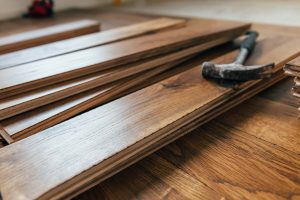 Common Insects Found in Hardwood Floors:
Common Insects Found in Hardwood Floors:
Several insects are notorious for seeking refuge within hardwood flooring. Termites, with their insatiable appetite for cellulose, can silently wreak havoc beneath the surface. Powder post beetles, another formidable foe, can lay their eggs in the pores of hardwood, leading to structural damage over time. Identifying these potential intruders is crucial for the early detection and mitigation of infestations.
Termites, often referred to as "silent destroyers," can remain hidden for extended periods, making it imperative to recognize signs of their presence. Look out for sagging floors, hollow sounds when tapping the wood, or the discovery of discarded wings near windowsills. Powder post beetles, on the other hand, leave behind small, round exit holes and fine, flour-like powder—the telltale signs of their activity.
Signs of Infestation:
Detecting an insect infestation in your hardwood flooring requires a keen eye for subtle indicators. Pay attention to changes in the appearance of the wood, such as discoloration, warping, or the presence of tiny holes. Unusual sounds, like tapping or rustling, can also be indicative of insect activity beneath the surface. In severe cases, you may even notice a distinct odor, signaling decay caused by pests.
Regular inspections and maintenance routines are vital in identifying these signs early on. Prompt action can prevent further damage and save you from costly repairs down the line.
Prevention and Maintenance:
Proactive measures are key to safeguarding your hardwood flooring against insect infestation. Start by controlling the indoor environment—maintain optimal humidity levels and address any leaks or water damage promptly. Seal gaps and cracks in the flooring to deny pests easy access, and consider using hardwoods less attractive to insects.
Regular cleaning is another effective preventive strategy. Remove dust, debris, and potential food sources for insects, reducing the likelihood of infestation. Applying protective coatings, such as sealants or finishes, can further fortify your hardwood floors against invasive pests. Have more questions about hardwood flooring? Stop by our showroom today in Peterborough where one of our team members would be happy to answer any questions!
The hard choice between Luxury Vinyl & Hardwood Flooring
Choosing the right flooring for your home is a significant decision that involves considering various factors, especially when debating between Luxury Vinyl Plank (LVP) and Hardwood Floors. Both options have their own set of advantages and drawbacks, and understanding these factors can help you make an informed decision that aligns with your preferences, lifestyle, and budget.

**1. Aesthetic Appeal:**
Luxury Vinyl Flooring (LVF) has made remarkable strides in mimicking the look of hardwood. The technology behind LVP allows for realistic textures and patterns that closely resemble natural wood. However, some individuals still appreciate the timeless and authentic beauty of hardwood floors. The warmth and character of real wood add a unique charm to a space that luxury vinyl might emulate but only partially replicate.
**2. Durability:**
LVP is celebrated for its durability, making it an excellent choice for high-traffic areas, families with pets, or homes with children. Luxury vinyl is resistant to scratches, stains, and moisture, providing a robust flooring option that stands up well to everyday wear and tear. On the other hand, hardwood floors, while durable, are more susceptible to scratches and can be adversely affected by moisture.
**3. Cost Considerations:**
Budget plays a crucial role in flooring decisions. Luxury vinyl flooring often comes at a lower price point than hardwood. Additionally, installation costs for LVP are generally lower, making it a more cost-effective option. Hardwood floors, while timeless and elegant, tend to have a higher upfront cost, and installation costs can vary depending on the type of wood chosen.
**4. Installation and Maintenance:**
Luxury vinyl flooring is known for its ease of installation, and many varieties come with click-and-lock systems, making it a popular choice for DIY enthusiasts. Furthermore, LVP is relatively low maintenance, requiring simple cleaning routines to keep it looking pristine. Hardwood, however, demands more attention during installation, and maintenance involves periodic refinishing and careful cleaning to preserve its natural beauty.
**5. Environmental Impact:**
Sustainability is a growing concern for many homeowners. Hardwood floors, when sourced responsibly, can be an environmentally friendly choice, especially if the wood is certified by organizations like the Forest Stewardship Council (FSC). On the other hand, luxury vinyl flooring is often made from synthetic materials, which may not be as environmentally sustainable. However, advancements in eco-friendly vinyl options are emerging, catering to those seeking a more sustainable choice.
**6. Comfort and Insulation:**
Hardwood floors have a natural warmth that adds comfort to a home. They are also conducive to underfloor heating systems. Luxury vinyl, while providing a softer surface compared to hardwood, may not have the same insulating properties. Consider the climate in your region and your preference for underfoot comfort when deciding between the two.
**7. Resale Value:**
The resale value of a home is influenced by various factors, and flooring choice is one of them. Hardwood floors are often considered a premium feature that can increase the perceived value of a property. Some potential buyers may prefer the authenticity and luxury associated with hardwood over vinyl. However, the resale value impact may vary depending on the local real estate market and buyer preferences.
**8. Moisture Resistance:**
One of the significant advantages of luxury vinyl flooring is its resistance to moisture. LVP can be installed in areas prone to high humidity, such as basements and bathrooms, where hardwood might not be a suitable option. If your home is in an environment where moisture is a concern, LVP could be the more practical choice.
9. Longevity
Hardwood floors have a long lifespan and can be refinished multiple times, allowing them to last for generations. While luxury vinyl is durable, it may not have the same longevity as hardwood. Consider your long-term plans for the property when deciding between the two.
10. Allergens and health concerns
For individuals with allergies, luxury vinyl flooring is a favorable option as it does not harbor allergens and is easy to clean. Hardwood floors, if kept clean and free of mold, can also be a suitable choice. Consider your family's health needs and whether anyone in the household has specific allergies when making your decision.
In conclusion, the choice between Luxury Vinyl Plank and Hardwood Floors depends on a multitude of factors. Assessing your priorities, budget constraints, and the specific requirements of each room in your home will guide you toward the flooring option that best suits your needs. Whether you opt for the timeless elegance of hardwood or the practicality of luxury vinyl, both choices can enhance the beauty and functionality of your living space. Contact our team to learn more about the different options that we offer in Peterborough!
Hardwood Flooring vs. LVP: Decoding the Right Fit
Choosing the right flooring for your home is a significant decision, and two popular contenders in the market are hardwood and luxury vinyl plank (LVP) flooring. Both options have their unique characteristics, and understanding the differences can help you make an informed choice. In this comprehensive comparison, we'll delve into the world of hardwood and luxury vinyl plank flooring, exploring aspects like durability, aesthetics, maintenance, and installation. Let's go ahead and decode the perfect flooring choice for your home.
- Durability:
Hardwood Flooring: Hardwood floors are renowned for their timeless appeal and longevity. High-quality hardwoods, such as oak or maple, can withstand decades of wear and tear. However, they are susceptible to scratches, dents, and moisture damage, making them less ideal for areas with high foot traffic or humidity.
Luxury Vinyl Plank Flooring: LVP flooring, on the other hand, is designed with durability in mind. Its composition of PVC and wear layers makes it resistant to scratches, stains, and water. This makes luxury vinyl plank flooring an excellent choice for high-traffic areas, kitchens, and bathrooms where hardwood may struggle.
- Aesthetics:
Hardwood Flooring: Hardwood floors exude warmth and natural beauty, offering a classic and elegant look. The variety of wood species, colors, and grain patterns provide homeowners with diverse options to match their interior design preferences. However, hardwood can fade or change color over time due to exposure to sunlight.
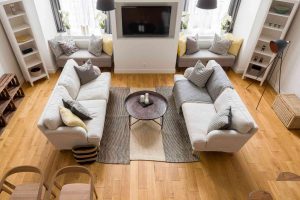 Luxury Vinyl Plank Flooring: LVP flooring has made significant strides in replicating the authentic appearance of hardwood. Advanced printing and embossing technologies enable luxury vinyl planks to mimic the texture and grain of real wood convincingly. With an extensive range of styles and colors, LVP allows homeowners to achieve the look of hardwood without sacrificing practicality.
Luxury Vinyl Plank Flooring: LVP flooring has made significant strides in replicating the authentic appearance of hardwood. Advanced printing and embossing technologies enable luxury vinyl planks to mimic the texture and grain of real wood convincingly. With an extensive range of styles and colors, LVP allows homeowners to achieve the look of hardwood without sacrificing practicality.
- Maintenance:
Hardwood Flooring: Maintaining hardwood floors requires regular sweeping, vacuuming, and occasional polishing. Harsh cleaning agents and excessive moisture should be avoided to prevent damage. Refinishing may be necessary to address scratches and wear, adding to the maintenance effort and cost.
Luxury Vinyl Plank Flooring: One of the key advantages of LVP flooring is its low maintenance. It is resistant to moisture, stains, and scratches, making it easy to clean with a simple sweep or mop. The protective wear layer also contributes to its longevity, reducing the need for refinishing over time. This makes luxury vinyl plank flooring a hassle-free option for busy households.
- Installation:
Hardwood Flooring: Installing hardwood floors can be a complex and time-consuming process. It often involves nailing or gluing individual planks to a subfloor, which may require professional installation. Hardwood is also sensitive to changes in humidity, requiring acclimation before installation.
Luxury Vinyl Plank Flooring: LVP flooring offers various installation options, including click-lock systems, glue-down, or loose lay. The versatility of installation methods makes it a DIY-friendly choice for homeowners. Additionally, luxury vinyl plank flooring is more forgiving in terms of subfloor conditions, making it a quicker and more accessible installation process compared to hardwood.
Conclusion:
In the hardwood vs. luxury vinyl plank flooring showdown, the perfect choice depends on your priorities and lifestyle. Hardwood floors bring a timeless aesthetic to your home but come with higher maintenance and potential durability challenges. On the other hand, luxury vinyl plank flooring offers durability, versatility, and a realistic wood look without the demanding upkeep of hardwood.
Whether you opt for the classic charm of hardwood or the modern practicality of luxury vinyl plank flooring, both options bring their unique charm to your living space. Consider your preferences, lifestyle, and budget to make the best choice for a flooring solution that seamlessly blends beauty and functionality in your home. Still not sure? Connect with one of our team members today!
Luxury Vinyl Flooring vs Hardwood Flooring: Which is Right for You
When it comes to choosing the perfect flooring for your home, two popular options often come to mind: luxury vinyl flooring and hardwood flooring. Both offer unique benefits and aesthetics, but understanding the key differences can help you make an informed decision. In this blog, we'll explore the pros and cons of luxury vinyl flooring and hardwood flooring to help you determine which one is the right fit for your lifestyle and preferences.
Luxury Vinyl Flooring:
Luxury vinyl flooring has gained immense popularity in recent years, and for good reason. It offers a wide range of styles, patterns, and colors, allowing you to achieve the look of natural materials like wood or stone at a fraction of the cost. Vinyl flooring is highly durable, resistant to scratches and stains, making it an excellent choice for high-traffic areas and households with pets or children. Additionally, its moisture resistance makes it suitable for bathrooms and kitchens. With advancements in technology, luxury vinyl flooring can now mimic the texture and grain patterns of real hardwood, providing a realistic and visually appealing alternative.
Hardwood Flooring:
There's no denying the timeless beauty and elegance of hardwood flooring. It adds warmth and character to any space, and its natural variations make each plank unique. Hardwood flooring is known for its durability and longevity, often lasting for generations when properly maintained. It can be sanded and refinished multiple times, allowing you to refresh its appearance. Hardwood also offers excellent resale value, as it is highly sought after by homebuyers. However, it's important to note that hardwood flooring is susceptible to scratches, dents, and moisture damage. It requires regular maintenance, such as refinishing and occasional resealing, to keep it looking its best.
Factors to consider:
1. Budget: Luxury vinyl flooring is generally more affordable than hardwood flooring, making it a cost-effective option for those on a tight budget.
2. Lifestyle: If you have a busy household with kids and pets, luxury vinyl flooring's durability and resistance to stains and scratches may be more suitable.
3. Aesthetics: If you value the natural beauty and authenticity of hardwood, and are willing to invest in its maintenance, hardwood flooring may be the right choice for you.
4. Moisture Resistance: If you're considering flooring for areas prone to moisture, like bathrooms or kitchens, luxury vinyl flooring's water resistance makes it a practical choice. Hardwood flooring, on the other hand, is more susceptible to water damage and may not be the best option for these areas.
5. Maintenance: LVP requires minimal maintenance. Regular sweeping and occasional mopping are usually sufficient to keep it looking great. Hardwood flooring, on the other hand, requires more attention and care. It may need refinishing and resealing over time to maintain its appearance and protect it from wear and tear.
6. Environmental Impact: If sustainability is a priority for you, hardwood flooring is a more environmentally friendly option. Hardwood is a natural, renewable resource, whereas luxury vinyl flooring is made from synthetic materials. However, it's worth noting that some luxury vinyl flooring options are made from recycled materials, which can help reduce their environmental impact.
In the end, the choice between luxury vinyl flooring and hardwood flooring depends on your specific needs, preferences, and budget. Luxury vinyl flooring offers a wide range of styles, durability, and affordability, making it a practical choice for many homeowners. On the other hand, hardwood flooring provides timeless beauty, authenticity, and the potential for higher resale value. Consider factors such as your lifestyle, desired aesthetics, maintenance requirements, and moisture resistance when making your decision.
Remember, it's always a good idea to consult with our flooring professionals or our visit showroom to see and feel the different options firsthand. We can provide expert advice based on your specific circumstances and guide you towards the flooring that best suits your needs.
How to repair scratches on Hardwood Floors
When it comes to repairing scratches and dents in hardwood floor, here are a few more tips for you. For minor scratches, you can use a hardwood floor touch-up pen or marker that matches the color of your floor. Just apply it to the scratch and gently blend it in. For deeper scratches or dents, you can try using a wood putty or filler. Apply it to the affected area, let it dry, and then sand it down until it's smooth. After that, you can finish it off with a wood stain or sealant to match the surrounding hardwood floors. Remember to always follow the instructions on the products you use and take your time with the process. Let me know if you need any more help!
Here's a step-by-step guide to repairing hardwood dents and scratches:
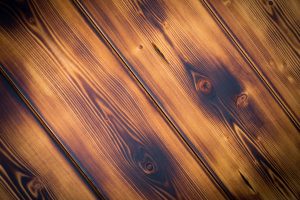 1. Clean the area: Start by cleaning the scratched or dented area with a wood cleaner and a soft cloth. This will remove any dirt or debris.
1. Clean the area: Start by cleaning the scratched or dented area with a wood cleaner and a soft cloth. This will remove any dirt or debris.
2. Assess the damage: Take a closer look at the scratches and dents to determine their severity. Minor scratches can often be fixed with simpler methods, while deeper dents may require more extensive repairs.
3. Minor scratch repair: For minor scratches, you can use a hardwood floor touch-up pen or marker that matches the color of your floor. Apply it to the scratch and gently blend it in. Make sure to follow the product instructions for the best results.
4. Deeper scratch and dent repair: For deeper scratches or dents, you can use a wood putty or filler. Apply the filler to the affected area, making sure to fill it completely. Smooth out the excess filler using a putty knife or a scraper. Allow the filler to dry according to the manufacturer's instructions.
5. Sanding: Once the filler is dry, gently sand the repaired area using fine-grit sandpaper. This will help to level the surface and create a smooth finish. Be careful not to sand too aggressively, as you don't want to damage the surrounding wood.
6. Staining or sealing: After sanding, you may need to apply a wood stain or sealant to match the surrounding floor. Test the stain or sealant on a small, inconspicuous area first to ensure it matches the existing color. Apply it evenly to the repaired area using a brush or cloth, following the product instructions.
7. Finishing touches: Allow the stain or sealant to dry completely before walking on the repaired area. If necessary, apply additional coats for a more seamless blend.
Remember, the key to successful repairs is patience and attention to detail. Take your time and follow the instructions for each step. If you're unsure about any part of the process, it's always a good idea to consult a professional. It is also important to remember, just because your flooring looks like hardwood, does not necessarily mean it is. Luxury Vinyl Flooring can look very similar to hardwood floors depending on the pattern. So ensure its not Luxury Vinyl Flooring before starting the repair!
Still not feeling confident? Connect with one of our employees, and we can walk you through the different options!





